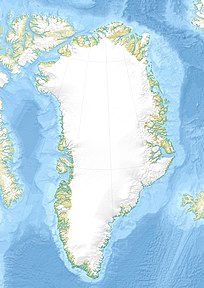Aappilattoq (Nanortalik)
| Aappilattoq (red, edible seaweed) | ||
|---|---|---|
| Augpilagtoĸ | ||
| Aappilattoq (2005) | ||
| Commune | Kujalleq municipality | |
| District | Nanortalics | |
| Geographical location | 60 ° 8 ′ 0 ″ N , 44 ° 18 ′ 0 ″ W | |
|
|
||
| Residents | 100 (January 1, 2020) |
|
| founding | 1922 | |
| Time zone | UTC-3 | |
Aappilattoq [ ˈaːpːiˌlatːɔq ] (according to the old spelling: Augpilagtoĸ ) is a Greenlandic settlement in the Nanortalik district in the Kujalleq municipality .
location
Aappilattoq is located on a small peninsula at the point where the three fjords Torsukattak , Illua and Qoornoq intersect. The Prins Christian Sund also borders directly to the east . Only in the north is the settlement not separated by water, but by towering mountains. The closest place is Narsarmijit 26 km southwest. Aappilattoq is the easternmost town in West Greenland.
history
Aappilattoq was inhabited as early as 1880. 13 residents of the residential area have been handed down for 1900. Then he was left. In 1922, due to the good fishing grounds, an Udsted was built on the site of the former living space , which replaced the Pamialluk , which was abandoned at the same time . For this purpose an apartment for the Udsteds administrator, a packing house, a shop and a fish house were built. The school band was taken over from Pamialluk. In 1957 a school was built. In 1985 a church was built that completely replaced the old chapel from Pamialluk.
In 1930 169 people lived in Aappilattoq, in 1940 there were 122, in 1950 199 and 1960 238.
economy
The place typically lives from fishing and hunting . The Pilersuisoq branch, the school and the village administration offer further work opportunities . The fish factory in Aappilattoq was renovated from 2012 to 2014. Hats , black halibut and striped sea wolves in particular are hunted, caught and processed. Sealskin is traded locally or in Qaqortoq .
Another possible source of income is tourism . Due to the high mountains surrounding the town and its location on the cruise ship route of the Prins Christian Sund, Aappilattoq is attractive for mountaineers .
Infrastructure and supply
Aappilattoq has a natural harbor with a quay and a pontoon bridge , from where the boat traffic runs. Air traffic is handled via the Aappilattoq heliport .
The houses are not connected to a sewage system , but most of them have an electricity connection. The current is taken in 2015 in operating power plant of Nukissiorfiit produced. The drinking water supply is provided by a closed stream in the northwest, from which water pipes lead to the individual houses. Aappilattoq is also connected to telecommunications . Waste is dumped or incinerated .
Development
The school had five students in 2016/17. The village has a community workshop, a shop and a fire station renovated in 2007. The service building has a laundry, sanitary facilities and also serves as a village meeting place. There is a soccer field in the north. To the north of the church is the currently used cemetery, while further north is another historical cemetery.
Population development
Aappilattoq is a typical example of emigration to Greenlandic villages. Although the town has had a relatively constant population since 2014, it has more than halved in the last 40 years.

Web links
Individual evidence
- ↑ Map and surroundings at mapcarta.com
- ↑ Jens Christian Madsen: Udsteder og bopladser i Grønland 1901-2000 . Atuagkat, 2009, ISBN 978-87-90133-76-4 , pp. 56 f .
- ↑ a b Aappilattoq at kujalleq2017.odeum.com
- ↑ Aappilattoq at kujalleq.gl
- ↑ Population Aappilattoq 1977–2020 at bank.stat.gl



